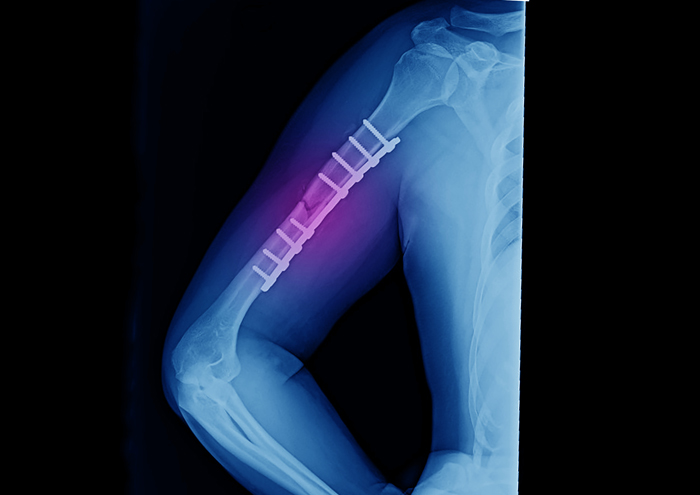Open Reduction Internal Fixation Treatment & Diagnostics in Tardeo, Mumbai
Open Reduction Internal Fixation (ORIF)
Introduction
Multiple fractures or dislocation of the bones happens primarily because of severe accidents. Plasters do not fix such serious fractures, and people are advised to undergo Open Reduction Internal Fixation (ORIF). “Open reduction” means the realignment of the bone fracture with an incision in your skin. “Internal fixation” refers to the insertion of rods, screws, plates to keep the bone in a stable position to increase healing, and prevent infection.
Open Reduction Internal Fixation (ORIF) is suggested by your doctor if your bone breaks multiple times, is dislocated, and sticks out of your skin. If the bone has been previously realigned, without incision (closed reduction), then you need to undergo ORIF.

What are the Symptoms of Fracture or Dislocation of bones?
Some common symptoms associated with fracture or dislocation of bones are:
- Out-of place limb or joint
- Intense pain, and numbness
- Swelling, bruising, and bleeding
- Protruding bone
- Limited mobility of the limb
What are the Causes of Fracture or Dislocation of bones?
As a result of an accident, sudden jerk, or falling from a certain height with high force will result in fracture, and dislocation of the bones. This fracture might be in one bone, multiple bones, or multiple positions in a bone.
When to Consult a Doctor?
You must see a doctor if you have multiple fractures of the bone. In some severe situations, when plasters cannot fix the fracture, you might have to undergo Open Reduction Internal Fixation (ORIF).
Request an appointment at Apollo Hospitals
Call 1860 500 2244 to book an appointment.
Preparing for Open Reduction Internal Fixation (ORIF)
Before ORIF, the doctor will examine your broken bone by a blood test, X-Ray, MRI scan, and CT scan. After the examination, you will be administered either with general anesthesia, or local anesthesia.
How is Open Reduction Internal Fixation (ORIF) done?
Open Reduction Internal Fixation (ORIF) is performed in two steps – open reduction, and internal fixation. During an open reduction, the surgeon will make an incision in your skin, and move the bone to its normal position. Bone fragments are removed and damaged soft tissue is repaired. This is followed by internal fixation in which any type of hardware is used. Hardware like metal rods, screws, plated, or pins are attached to the bone to hold it together. This hardware can be inserted permanently, or temporarily and removed after healing. The incision is closed with stitches, and a bandage is applied. Limbs are put in a stable position with the help of a cast, or splint.
What are the Benefits of Open Reduction Internal Fixation (ORIF)?
ORIF has a high success rate and post-surgery you can return to normal life in less time duration. After undergoing ORIF, you don’t need a plaster for a long duration and the recovery is fast. If you have been through complex surgery, ORIF is the best surgical treatment.
Risks or Complications related to Open Reduction Internal Fixation (ORIF)
Although ORIF is a safe surgical procedure, yet there might be some risk associated with it, like:
- Bacterial infection due to hardware or incision
- Swelling
- Bleeding or blood clotting
- Tendon or ligament damage
- Mobility of the installed hardware
- Muscle spasm
After Open Reduction Internal Fixation (ORIF)?
After undergoing ORIF you might have to stay at the hospital overnight depending upon the severity of the fracture. Post-surgery pain and swelling can be reduced by applying an ice pack and consuming painkillers prescribed by the doctor. You must elevate the treated limb and give it proper rest to reduce the inflammation. The surgical site must be kept clean and dry.
Conclusion
Our bones contain blood vessels that promote the healing of bones. Healing and repairing of bones take time, so you must be cautious after the ORIF. You must have a proper diet rich in calcium and vitamin D. By wearing pads, or braces on the treated joint, you can reduce the risk of future fracture and decrease pressure on your joints.
Usually, after undergoing internal fixation of small bones, hardware can be removed after some time. While in some fractures, internal fixation can be permanent.
You must not walk until 6 weeks after the surgery. After a while, you will be allowed to walk in a walking boot.
After ORIF, you must sleep with a specialized pillow for elevation, keeping broken bones above your heart to prevent pooling of blood, and swelling.
ORIF is used when the fractures are at or close to the joints, where the healing of bone cannot be done solely by cast or splint.
Our Top Specialities
NOTICE BOARD
CONTACT US
CONTACT US
 Book Appointment
Book Appointment


.svg)
.svg)
.svg)
.svg)








